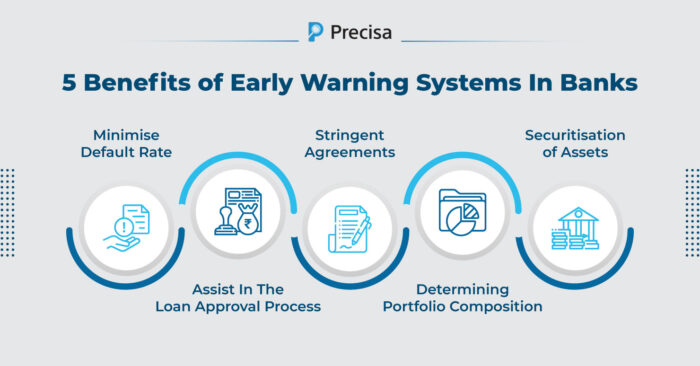Early Warning System in Banks: A Guide to its Role in Preventing Failures

The global digital lending market, which stood at $12.6 billion in 2022, is projected to reach $71.8 billion by 2032, growing at a CAGR of 19.4% from 2023 to 2032, as per Allied Market Research.
Globally, the COVID-19 pandemic disrupted traditional banking channels due to frequent lockdowns and the need to practise social distancing. This led to a surge in demand for contactless digital solutions. Moreover, improved user experience and technological innovations have strengthened the shift toward digital banking and lending.
However, the digital lending surge also brought a new challenge, growing default risks. A ResearchGate study revealed that default rates for digital lending are higher when compared to traditional lending. The default rate for payday loans for digital loans was 13.8%; it was 7.1% for traditional loans.
In this scenario, a robust onboarding process that focuses on holistic risk assessment of the applicant combined with an innovative EWS or early warning system in banks can help lenders minimise their defaults and improve risk management.
This blog explores the role of an early warning system in banks in preventing failure in banks.
What Is an Early Warning System in Banks?
An early warning system in banks refers to analytical solutions that leverage innovative techniques like Machine Learning and Artificial Intelligence to help make the lending process more secure and streamlined.
- An EWS monitors, reports and alerts lenders to anomalies, risks and potential frauds and defaults and therefore help avoid or mitigate any future losses.
- These systems help lenders identify early warning signs in the lending process. To note, there is no universal model or norm to define an early warning sign. It can be any undesirable aspect that makes a borrower stand out.
- An early warning system in banks analyses hundreds of diverse data points and signals for intelligent forecasting.
Fluctuating cash flows, declining sales, in the case of a business and aspects like a high debt-to-income ratio and decreased credit score for an individual could be early indicators of trouble.
5 Benefits of An Early Warning System in Banks
An automated early warning system in banks helps track the credit health of borrowers and works round the clock to track events that are leading indicators of distress. This allows them to be proactive rather than reactive, and take timely and appropriate measures to reduce potential losses.
The five benefits of EWS for banks are discussed below.
1. Minimise Default Rate
An early warning system in banks monitors and tracks customer portfolios systematically. The system helps banks check their asset quality by looking at relevant indicators that trigger required action in case there are any red flags. Moreover, the EWS allow them to spot signs of distress that would not be possible through manual monitoring.
For example, Days Past Due (DPD) is one such indicator which can help lenders to make informed judgements about credit restructuring, repayment conditions, and risk management.
2. Assist in the Loan Approval Process
Banks sanction loans after assessing an applicant’s credit health. Loan origination software integrating an early warning system in banks enables lenders to evaluate the prospective borrower’s creditworthiness by accessing data from multiple sources.
Consequently, banks can make more informed and objective decisions by looking at existing debts and borrowers’ ability to repay their debts. This helps banks accelerate the traditional due diligence process. Banks can also improve their portfolio quality and weed out applicants likely to default at the application stage.
3. More Stringent Agreements
An early warning system in banks helps monitor if a borrower’s collateral remains in line with the credit risk policies and conditions set at the time of loan origination.
Banks can assess a loan’s financial viability and decide to have higher collateral if required. EWS helps lenders maximise recovery by early intervention once a loan comes under the watch list. Regular supervision and stricter norms for collateral enable banks to minimise their losses if an actual default occurs.
4. Determining Portfolio Composition
AI-based EWS evaluates multiple industries, tracks the latest developments in diverse sectors and accesses multiple high-grade data points. This can help banks plan their portfolios better; banks can decide which sectors or industries they want to focus on.
Therefore, an early warning system in banks enables effective decision-making to limit exposure to default-prone sectors depending on these intelligent, data-driven inputs.
5. Securitisation of Assets
An early warning system in banks also aids lenders in proactively securitising assets, with warning signals linked to them. Lenders can also choose to sell assets where the revival chances are low.
Securitisation of assets helps lenders mitigate their losses by selling their NPAs to a special purpose vehicle (SPV) and asset reconstruction companies (ARCs) that deal with them. These companies take over NPAs, which helps the banks get them off their books.
Key Takeaways
Automation and emerging technology like AI and ML have changed the lending experience for lenders and borrowers alike. Banks can keep themselves secure and prevent failures by leveraging these techniques. An Early warning system in banks can help them manage risk, mitigate losses and improve the overall lending process, helping banks guard their and customers’ financial health.
Precisa offers a sophisticated analytics platform tailored for banks, NBFCs and other lending institutions. This platform aids in evaluating bank statements, ensuring robust fraud risk assessments and pinpointing any irregularity.
The Bank Statement Analyser from Precisa is an analytics tool that can help lenders identify early warning signs. It extracts data from the bank statement, classifies and categorises transactions, analyses the data, and detects fraudulent transactions and other anomalies.
Book a free trial to learn more.



